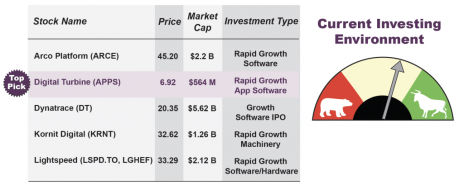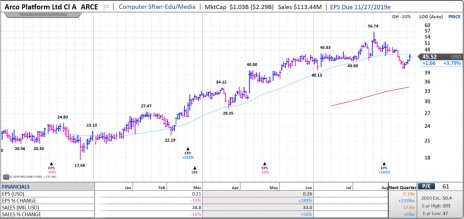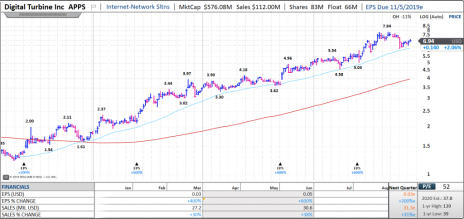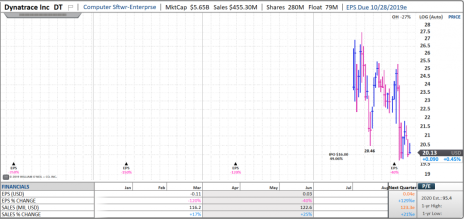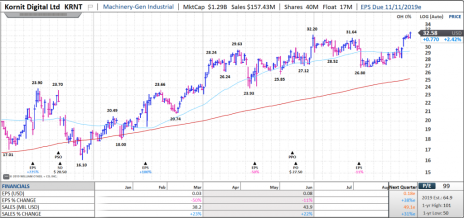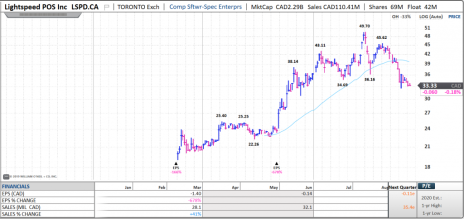Welcome to the first Issue of Cabot Early Opportunities. This month’s Issue delves into a number of fast growing software names that look good on modest pullbacks, as well as one that’s brand new to the public market. I also cover some early-stage stocks posting big growth from beyond U.S. borders. We don’t venture too far down the market cap curve, or get into any pre-revenue names this month. But we will, once this modest growth to value rotation is behind us. Enjoy!
Cabot Early Opportunities 101
The Great Migration, or “Normal” Rotation?
In each of the last three years September has kicked off a wave of growth stock selling that rivals the magnificence of the Great Wildebeest migration across Northern Tanzania and Kenya.
It has been, at times, pure chaos. Investors can’t seem to move quickly enough. They fight among themselves to ditch growth stocks hand over fist. Many get trampled, pulled under water, or plucked from the pack and gobbled up.
But in contrast to the Great Migration, where millions of wildebeest, zebras and gazelles move through the landscape in search of greener pastures, many investors don’t know where they’re headed, or why.
They just know change is afoot, growth stocks are going down and it feels right to do something. So they sell!
That sentiment does make some sense. You can’t always run against the herd. But we’ve also seen growth stocks go through these rotations relatively quickly, leaving those that made too many all-or-nothing decisions frustrated and burned.
This year the most notable change in September is the relative outperformance of value stocks as compared to growth stocks. Month-to-date, large- and small-cap value stocks are both up 8.5% and are beating their growth stock counterparts by 3.6% and 4.7%, respectively.
As many Cabot subscribers already know, these rotations (or migrations if you prefer that analogy) are circular and not unidirectional.
It isn’t possible to predict with pinpoint accuracy when growth stocks will start to look strong again (although many are already looking better than they did two weeks ago). But they will. And as harsh as the selling has been around September over the last three years, the eventual buying has been equally spectacular.
These cycles have worked out better for investors that made incremental moves and had the clarity of mind to step in and buy select names when the price was beaten up.
In this inaugural Issue of Cabot Early Opportunities, I feature several growth-oriented, early-stage companies that could offer good entry points right now. I also sprinkle in a few opportunities to gain exposure to growth trends beyond U.S. borders.
WHAT TO DO NOW
Stepping back to look at the big picture here in the U.S., we see consumer spending appearing to hold strong, the Fed having already cut rates once, with one or more rate cuts likely in the coming months, and concerns over an inverted yield curve dying down (the S&P 500 dividend yield remains above the 10-year U.S. Treasury bond yield).
With that backdrop the odds favor the U.S. economy continuing to grow, even if at a modest clip.
Most importantly, the outlook isn’t bearish for early-stage growth stocks, which I believe will can overcome recession fears and deliver handsome gains to investors over the next six to 12 months.
The best thing to do now is make incremental moves. Take partial profits on stocks where you have gains but that are starting to falter, or where you just feel a small reduction in position size is warranted to lock in some gains. Take bigger steps back, or step aside completely, from stocks that haven’t worked in months and are really falling apart. And look to be a selective buyer of strong stocks and those that have pulled back recently, but which are not broken and continue to have good growth potential.
This month’s Top Pick is Digital Turbine (APPS). It’s a small-cap stock, that used to be a penny stock, but which is emerging as a more sustainable growth story due to a content distribution platform for mobile devices running the Android OS.
There’s also a smattering of early-stage companies that are relatively new to the public market, including one spinoff that has big potential, but which is so new to the market there’s no stock trend to speak of.
Enjoy!
Arco Platform (ARCE)
THE COMPANY
Arco Platform (ARCE) offers a disruptive, 100% subscription-based software platform for delivering integrated education content to K-12 private schools in Brazil. The $2.2 billion market cap company prides itself on technology innovation and has the data to back up claims that its solutions help improve academic results.
Like most parents, Brazilians want their school-age kids to use tools that permit personalized learning, while giving some insight into progress and roadblock resolution. This is what Arco offers the Brazilian market, which is marked by mediocre academic results from many small and geographically distributed schools, which makes teaching staff somewhat inefficient.
Arco’s solutions offer schools a one-stop shop for both content and school management tools. While it has under 10% market share today, Arco stands out in a crowded marketplace because the entire offering is integrated; schools don’t need to buy from different vendors and struggle to patch them together.
The business should continue to grow rapidly due to market share gains, acquisitions and pricing power. Revenue was up 33%, to $100 million, in 2018 when EPS rose 65%, to $0.66. Not factoring in recent acquisitions, revenue should jump 20% this year and 33% in 2020. EPS should increase 44% and 7%, respectively.
Arco has announced three proposed acquisitions in recent months which will dramatically increase scale and revenue. First is Positivo, another K-12 content provider. This acquisition is progressing through regulatory procedures and when closed will more than double the size of the business, to over 4,800 schools and 1.2 million students.
On the Q2 2019 earnings conference call management also announced the acquisitions of Nave à Vela (supplemental content) and Escola em Movimento (engagement app for parents and students). Collectively, these acquisitions should keep Arco on the forefront of the innovation and engagement curves.
THE STOCK
Arco Platform launched in 2006 and went public in September 2018 at 17.5. The stock was stable after the IPO, rose into lockup expiration in late-March of 2019, and trended higher through August, mostly above its 50-day line and making a series of higher highs and higher lows. Shares spiked to an all-time high of 56.7 in mid-August and have pulled back with the market since. They are currently 23% off that all-time high, and below their 50-day line.
Digital Turbine (APPS)
THE COMPANY
TOP PICK
Digital Turbine (APPS) is a $580 million market cap company that offers a mobile delivery platform for the Android OS that helps consumers find apps on their mobile devices. Customers are mobile device operators, app developers and original equipment manufacturers (OEMs). They all want to capture the attention of consumers. And can generate revenue by linking us all up with the apps we use, then facilitating advertising campaigns that flow from brands to eyeballs.
Since its founding in 1998 Digital Turbine has delivered over 2.3 billion app pre-loads on over 300 million devices. Yet it’s only penetrated around 10% of the global Android smartphone market.
One growing OEM partnerships is with Samsung, which should span 50 countries this quarter, up from 12 last quarter. A partnership with Telefonica should also drive new devices to launch this year. Other OEM customers include Acer, Lenovo, Motorola and ZTE. Digital Turbine has deals with major operators too, including Verizon (VZ) and AT&T (T), as well as TracFone, U.S. Cellular (USM) and American Movil (AMX). Verizon accounted for 42% of revenue in Q2, while AT&T/Cricket Wireless accounted for 33%.
The core product is Ignite, a software platform that lets mobile operators and OEMs control, manage and generate revenue through app installation, both when the device is activated and by the consumer. Ignite can also recommend apps, send notifications to engage users, and, with the release of Single Tap, help them easily install apps from mobile ads.
The key drivers of the business are the products Digital Turbine adds to the platform, the number of devices the platform gets installed on, and how much advertisers are willing to pay to use it. The trends have been bullish. Digital Turbine’s revenue jumped by 43% to $100 million in 2019 and EPS of $0.08 turned positive from a loss of -$0.05 in 2018. In Q1 fiscal 2020 (reported August 5) revenue rose 38% to $30.6 million and EPS of $0.05 beat by $0.02. Looking to full-year 2020, analysts see revenue up 30% to $130 million and EPS surging 125% to $0.18.
THE STOCK
APPS has been public for years but only began to perform as the business and business model firmed up. It didn’t break out of the penny stock category until late 2017 when shares eclipsed a dollar per share. After a run to 2.6 they headed back in that direction late in 2018. But APPS roared back in 2019 and has been steadily climbing all year, making a series of higher highs and higher lows above its 50-day line. APPS is currently just 11% off its all-time high.
Dynatrace (DT)
THE COMPANY
If you’ve read any of my research you already know one of the reasons I’m bullish on cloud software stocks is because these solutions offer massive efficiency improvements, largely because they automate repetitive processes. As software adoption grows and the global digital transformation progresses, companies need to monitor the performance of all their newfangled solutions!
This is what Dynatrace’s (DT) software does. The $5.7 billion market cap company was founded in 2005, and spun out by Thoma Bravo in 2014. Management retooled the business from 2013 to 2016 to take advantage of newer technolgies and transition to a subscription business model. It now has 2,300 customers and is leading the charge in an $18 billion (and growing) addressable market.
In 2016 Dynatrace released its new platform for application performance monitoring (APM). The new and improved version better meets customer needs across on-premise, private cloud, and public cloud solutions. Dynatrace’s platform is also expanding into infrastructure monitoring and log management, meaning it could cover the three biggest areas of monitoring solutions. Keys to the platform are single agent (OneAgent), a full-stack service map (Smartscape) and a proprietary AI engine (Davis).
Dynatrace’s historical revenue trend is mired by the transition from licenses to subscription. That’s why fiscal 2019 revenue (ended March 31) was only up 8%. But it’s over the hump now. Looking to 2020, analysts see revenue up 21%, and an average annual growth rate near 25% for the next four years. Debt, which is over
$1 billion now, should trend down as recurring revenue ramps up. Estimated EPS in FY 2020 is $0.21, a big improvement from a loss of -$0.41 in fiscal 2019.
THE STOCK
DT just came public on August 1 at 16. The stock popped almost 50% the first day but has since pulled back to 21. There is no trend to speak of due to the newness of the stock. It isn’t something you need to rush out and buy today; averaging in over time is critical here. Insider lockup is still ahead and with Thoma Bravo continuing to own over 50% of shares we should expect to see new shares hit the market as Thoma Bravo reduces its position. Those events will give us a good sense of market demand as we move forward.
Kornit Digital (KRNT)
THE COMPANY
Kornit Digital (KRNT) is an Israeli company that specializes in industrial digital printing technologies for apparel and textiles. The big picture trends behind the growth are mass market adoption of custom-printed textiles and personalized garments, along with demand for more environmentally friendly printing solutions. Kornit has a market cap of $1.25 billion.
The company is both a beneficiary and a force behind the trends, which have gathered steam because of online shopping and social media. Manufactures have tried to respond through supply chain innovations that allow for short runs and just-in-time manufacturing. Both are intended to cut time to market and reduce wasted inventory.
Kornit has been developing complete digital printing solutions since it was founded in 2002. It now offers a full set of solutions, from direct-to-fabric (DTF) and direct-to-garment (DTG) printers, software, inks and consumables, and value-added services.
Historically, both DTF and DTG printing required five steps. Kornit’s equipment can do DTG in two, and DTF in just one! That’s a huge time saver. And the recent launches of the Atlas (mass market DTG), Avalanche Poly Pro (DTG specialty) and Presto (on-demand DTF) are all expected to make this technology available to more potential customers.
Growth is solidly above 20%. 2018 revenue rose by 27%, and it’s on track to rise 29% in 2019, when EPS should jump 32% to $0.49. In 2020 analysts see revenue up 28% and EPS surging 86%, to $0.91. Management has indicated that it’s looking to boost growth and opportunities through M&A, primarily software that improves workflow.
Kornit’s success may best be shown through customer examples. Spreadshirt, which prints over 5.5 million items a year, is a customer and has recently added to its fleet of DTG printers, including the Atlas for high capacity and the Avalanche Poly Pro for sports and athleisure. Adidas is another customer and is beginning to use the Atlas and Poly Pro. Kornit’s equipment has also been used in the Merch by Amazon program, a self-service platform that lets creators design tee-shirts that consumers can order.
THE STOCK
KRNT went public at 10 in early 2015 and didn’t have a great start. It traded down near 9 in 2016 then re-gathered momentum and reached 22 in mid-2017. Another pullback followed and KRNT was trading near 13 in early 2018. From there the trend has mostly been one of higher highs and higher lows, albeit with one dip below the 200-day line last December. While the trend is up and KRNT is trading right at all-time highs near 32 now, the stock does tend to move around and frequently pulls back below its 50-day line.
Lightspeed POS (LSPD.TO, LGHEF)
Note: All figures for Lightspeed are in CAD dollars, unless otherwise stated
THE COMPANY
Lightspeed (LSPD.TO), (LGHEF) is a $2.1 billion market cap company out of Montreal, Canada that has developed a cloud-based commerce solution for small businesses. The platform offers a point-of-sale (POS) system for brick-and-mortar retailers and restaurants, as well as an e-commerce system for online businesses. The business was started in 2005 by Dax Dasilva, the current CEO. As of mid-2019 the platform is live in over 50,000 customer locations (up 20% in Q1) in 100 countries. It’s catching on; over the last 12 months Lightspeed has processed more than $15.6 billion in gross transaction volume (GTV).
Lightspeed’s core market of small businesses are often forced to use a hodgepodge of solutions that don’t speak well together. In contrast, Lightspeed’s platform can do the heavy lifting, encompassing point-of-sale, loyalty, customer relationship, order management, inventory management and payment functions. Management continues to release new features to enhance the most complex challenges customers face, including omni-channel inventory tracking and payments, both of which launched in the U.S. in early 2019.
Lightspeed grew revenue by 31% in 2018 and 39% in fiscal 2019, when sales hit $101.7 million. Earnings in 2019 (-$2.88) were thrown off due to the company’s transition to the public market. In fiscal Q1 2020 (ended on June 30) revenue rose by 37.7% and EPS improved to a loss of -$0.11 from a loss of -$0.28. Over 90% of revenue continues to be for recurring software subscriptions.
Management issued full-year 2020 guidance that included revenue of $112 million to $115 million, implying growth of 45% to 48%. Lightspeed ended the quarter with $191 million in cash and no debt.
Lightspeed is everything you want to see in an early-stage opportunity. It’s young (founded in 2005), is going after a big market and is diversified (no customer accounts for more than 1% of sales and over 30% of revenue comes from outside of North America). And, management keeps rolling out new products every year or two that have a big, positive impact. That all said, Lightspeed operates in a competitive environment (against Square, Shopify, NCR, Clover, etc.) so expect some bumps in the road too.
THE STOCK
LSPD.TO went public at 16 in March 2019 and popped right away, rising to 24. It then pulled back and consolidated in the 22 to 25 range through May. Shares broke out after earnings in late May and rocketed higher through mid-July, making a series of higher highs and higher lows until they peaked just shy of 50. LSPD.TO pulled back with many high-growth names in September and is currently trading near 33.
PREVIOUSLY RECOMMENDED STOCKS
Note: Given that this is the first Issue of Cabot Early Opportunities there are no previously mentioned stocks at this time.
Below you’ll find previously recommended Cabot Early Opportunities stocks. Those rated HOLD are stocks that still look good and are recommended to be kept in a long-term oriented portfolio.
Stocks rated WATCH ran into trouble and were recommended to be sold at one point, but I felt they had potential to recover. These stocks could be bought again if they are featured in a future Cabot Early Opportunities Issue.
Those stocks rated DROPPED didn’t pan out and are no long on my watch list. They should be sold if you own them. DROPPED stocks are listed in one monthly Issue, then they fall off the DROPPED list and into oblivion.
Please use this list to keep up with my latest thinking, and don’t hesitate to call or email with any questions.
[/premium_html_footer]

